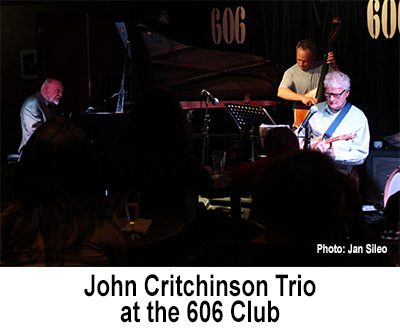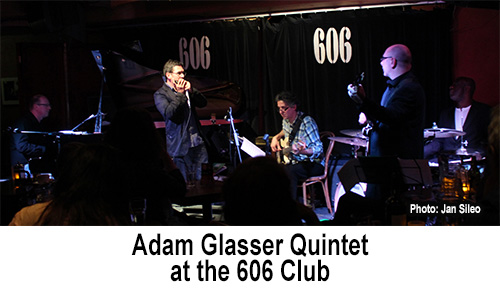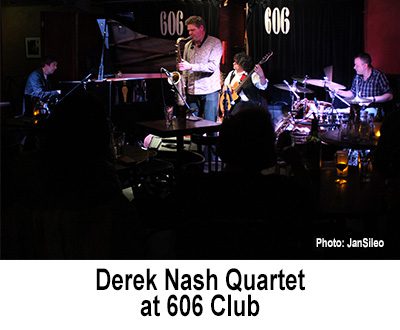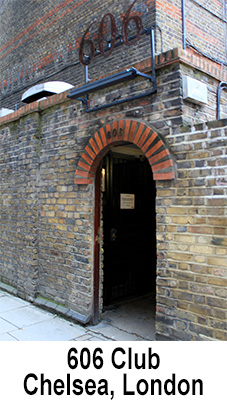It is often said that timing is everything. In the instance of a summer 2013 visit to London to experience the jazz scene there, our first visit was to the 606 Club on Lots Road in the Chelsea section of London. It could not have been a better choice. The downstairs club was also celebrating its 25th Anniversary. Accordingly, the Club had arranged for the presentation of 42 bands in 12 days—from May 22-June 2, 2013.
We were greeted by Laura G. Thorne, the Club’s Manager of Digital Marketing/Social Media/Content Development who made us feel more than welcome. The décor at 606 is not fancy. There is an adequate menu (they also serve lunch on Sundays). And there is space among the tables. In many clubs in New York City—such as Jazz Standard, Blue Note, and Birdland, among several others—you often feel you’re sitting on your neighbor’s lap, the tables and seats are so close. And if you order food, there is often not enough elbow room to bring your fork to your mouth. Clearly, just like the airlines, club management is looking to optimize every square inch of space. Not so at Club 606. The first thing you notice, other than the somewhat funky, retro-rustic decor, is the room to move around every table without disturbing anyone. The space welcomed and like a well-treated customer deserving of personal space to experience and enjoy the music.
 The real focus of 606 Club is the music: there is a Steinway Grand (well-tuned), properly focused lights, and a well-endowed sound system.
The real focus of 606 Club is the music: there is a Steinway Grand (well-tuned), properly focused lights, and a well-endowed sound system.
That particular evening we were treated to a trio of ensembles and a variety of jazz genres, starting with the John Critchinson Trio with the leader on piano and vocals. Also part of the trio was Dave Cliff on guitar, and Alec Dankworth on bass. Eighty-year-old John William Frank Critchinson, also known as “Critch,” is an English jazz pianist who, in the early 1950s worked part-time with saxophonist Ronnie Scott’s quartet (founder of Ronnie Scott’s jazz club). In 1979, he joined Ronnie Scott’s Quartet fulltime and stayed until it ceased working in 1995. Scott died in 1996. The trio’s repertoire on this particular night was right out of the Great American Songbook.
The next ensemble was the Adam Glasser Quintet. This group was a revelation whose originals and arrangements were 180 degrees from the Critchinson Trio. The font of this group’s sound is Adam Glasser whose use of his instrument—the harmonica—defies all myths about what the harmonica can or cannot do.
 Toots Thielemans is considered by many to be the world’s greatest harmonist. Adam Glasser is certainly in the same class. Both a pianist and an award-winning, world-class virtuoso harmonicist, Glasser is also a composer and arranger. Raised in South Africa, whose father, Stanley Spike Glasser, was himself a composer, Adam Glasser was exposed to musicians of many types. The Glasser Quintet set was totally compelling. In addition to Glasser’s highly melodic, accessible, and intriguing use of his instrument, the rhythmic patterns employed by the ensemble were, no doubt, right out of the South African musical landscape. One could also “feel” the “clavé” of Afro-Caribbean origin. The sounds grabbed you in the middle of your body and didn’t let go. The set could have gone on forever, it was that pleasurable. His latest album “Mzansi” was released by Sunnyside Records in the United States in 2012. Highly recommended. (http://www.adamglassermusic.com/)
Toots Thielemans is considered by many to be the world’s greatest harmonist. Adam Glasser is certainly in the same class. Both a pianist and an award-winning, world-class virtuoso harmonicist, Glasser is also a composer and arranger. Raised in South Africa, whose father, Stanley Spike Glasser, was himself a composer, Adam Glasser was exposed to musicians of many types. The Glasser Quintet set was totally compelling. In addition to Glasser’s highly melodic, accessible, and intriguing use of his instrument, the rhythmic patterns employed by the ensemble were, no doubt, right out of the South African musical landscape. One could also “feel” the “clavé” of Afro-Caribbean origin. The sounds grabbed you in the middle of your body and didn’t let go. The set could have gone on forever, it was that pleasurable. His latest album “Mzansi” was released by Sunnyside Records in the United States in 2012. Highly recommended. (http://www.adamglassermusic.com/)
The final musical offering at 606 Club that evening was the Derek Nash quartet with the leader on all four saxophones: soprano, alto, tenor, and baritone. Nash’s playing was both effortless and passionate. It didn’t make any difference the tempo or style, the playing was deeply felt and conveyed. His bio reads in part:
At the forefront of the British Jazz movement, Derek Nash is “one of the most versatile saxophonists in the UK today” (The Guardian). He has been a member of the Jools Holland Rhythm and Blues Orchestra since 2005, has led Sax Appeal for over thirty years, fronts the funk/fusion band Protect the Beat, and is a member of the Ronnie Scott’s Blues Explosion.
He is renowned for his energetic, vibrant, passionate and charismatic performances on all four saxophones — from sonorous baritone to soaring soprano — and is an award-winning performer having received the John Dankworth Award and the British Jazz Award (Small Group) for Sax Appeal; Best Jazz CD of the Year for Young Lions, Old Tigers with the late Spike Robinson and, most recently, was nominated for Jazz Musician of the Year by the Global Music Foundation and voted in the Top 3 Alto Saxophonists in the 2010 British Jazz Awards.
Nash’s family background again supports the contention that where you come from provides direction to where you’re going:
 Derek was born in Stockport, England, and is the son of Pat Nash, who was a respected arranger for the BBC Northern Dance Orchestra (NDO) for over thirty-five years. His musical journey started with piano, aged six, followed by saxophone, aged 13, having been inspired by hearing the NDO tenor saxophonist, Gary Cox, play The Pink Panther! He joined Stockport Schools Stagesound which, having won Music for Youth, led to performances in the Schools Proms at the Royal Albert Hall. It also led to performances with Ronnie Scott [there’s that name again], Don Lusher and Henry Lowther.
Derek was born in Stockport, England, and is the son of Pat Nash, who was a respected arranger for the BBC Northern Dance Orchestra (NDO) for over thirty-five years. His musical journey started with piano, aged six, followed by saxophone, aged 13, having been inspired by hearing the NDO tenor saxophonist, Gary Cox, play The Pink Panther! He joined Stockport Schools Stagesound which, having won Music for Youth, led to performances in the Schools Proms at the Royal Albert Hall. It also led to performances with Ronnie Scott [there’s that name again], Don Lusher and Henry Lowther.
The sax section of Stockport Schools Stagesound formed the early Sax Appeal, who went on to win the National Festival of Music for Youth (small band category), leading to more performances at the Royal Albert Hall and performing original compositions on television and radio for the Schools Proms. Whilst studying at University, Derek became the Musical Director of Stockport Schools Stagesound returning as conductor, once again, to the Albert Hall. (http://www.dereknash.com/biography)
Nash’s pianist Neil Angilley was a standout in the set. And no wonder. He also grew up in a musical environment with his grandmother and mother both playing piano and his father having played in brass bands all his life. The previous generation of ‘The Tamblyns’ (on his father’s side) had a complete family Brass Band formed by Neils’ great grandfather who played euphonium and flute. His grandmother played tenor horn with her sister playing tuba (she was so small she could have lived inside it!). Neils’ great uncle was awarded a baton engraved in silver for his services as Band Leader in 1915 Rouen, France during World War I. Neil first tickled the ivories at the age of three, and by the age of six was also playing the cornet in the Junior Band of St. Dennis. Neil won many prizes and competitions during his youth, and was awarded the “Best Musician of Cornwall” prize prior to accepting a place at the Royal College of Music in Kensington, London in 1985, studying piano, trumpet and composition (http://www.angilley.com/angilleyBio.htm ).
Angilley’s playing was entrancing. I could have listened to him all evening and into the next day. His virtuosity reminded me of the ease with which Art Tatum improvised in all keys at will!
The next evening we found ourselves in London’s Soho district at Ronnie Scott’s to hear British songstress Claire Martin with the Dave Newton Trio. What a contrast! More about this in next week’s blog.
Please write to me at meiienterprises@aol.com if you have any comments on this or any other of my blogs.
Eugene Marlow, Ph.D.
December 16, 2013
© Eugene Marlow 2013


